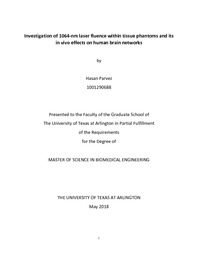
ATTENTION: The works hosted here are being migrated to a new repository that will consolidate resources, improve discoverability, and better show UTA's research impact on the global community. We will update authors as the migration progresses. Please see MavMatrix for more information.
Show simple item record
| dc.contributor.advisor | Liu, Hanli | |
| dc.creator | Parvez, Hasan | |
| dc.date.accessioned | 2018-06-05T19:09:01Z | |
| dc.date.available | 2018-06-05T19:09:01Z | |
| dc.date.created | 2018-05 | |
| dc.date.issued | 2018-05-22 | |
| dc.date.submitted | May 2018 | |
| dc.identifier.uri | | |
| dc.identifier.uri | http://hdl.handle.net/10106/27482 | |
| dc.description.abstract | For the past few decades there has been an increasing interest in the usage of near infrared (NIR) laser in the medical optics field. This is due to a number of studies conducted on different animal models utilizing NIR laser, which was reported to provide improvement in such cognitive functions as memory, decision making, and executive functions. The NIR laser produces no adverse effects in the human tissue, having a potential for treating different neurological disorders. However, there is limited knowledge related to the underlying mechanism of photon interaction with the human tissue. In this thesis, I tried to address this issue by conducting two separate studies.
For the first study, a series of different experimental protocols were performed utilizing laboratory tissue phantoms along with the 1064-nm laser. The goal of this part was to determine the dependence of optical fluence within the tissue phantom on (a) the power, (b) the beam size, and (c) the penetration depth of the laser. The results of the phantom study showed that optical fluence (1) had a linear relationship with the power of 1064-nm laser, (2) decreased with an increase in penetration depth. Also, an analytical expression was derived and proved to match well with the experimental results.
For the second part of study, I was interested in observing the modulation of electrophysiological signals in the human by the administration of 1064-nm laser. The experimental protocol included two different treatment groups, namely, the placebo treatment group and laser treatment group. In both treatment groups, right forehead of each subject was stimulated with different laser doses of the 1064-nm laser source. Electrophysiological data was recorded through the 64-channel EEG from 20 human subjects, and the functional connectivity was estimated using Pearson correlation coefficient (r). Statistically significant changes across different regions of the brain network were determined by comparing the two treatment groups. The results reported significant changes by the 1064-nm laser in the low-frequency oscillation bands, namely, the theta (4-7 Hz) and alpha (8-13 Hz) band. Both bands showed significantly enhanced connectivity in the frontal and occipito-parietal region. The total number of significant connections were increased during the treatment of laser. This study provided the first demonstration that transcranial infrared laser stimulation caused the modulation of lower- frequency oscillation bands in the human brain. | |
| dc.format.mimetype | application/pdf | |
| dc.language.iso | en_US | |
| dc.subject | Medical imaging | |
| dc.subject | Tissue optics | |
| dc.subject | Neuroscience | |
| dc.subject | Low level laser 1064-nm | |
| dc.subject | Horse blood | |
| dc.subject | Greens equation | |
| dc.subject | Transcranial photobiomodulation | |
| dc.subject | Brain network | |
| dc.subject | EEG | |
| dc.subject | Functional connectivity | |
| dc.subject | CCO | |
| dc.subject | Human brain | |
| dc.subject | Optical fluence | |
| dc.subject | Power of laser | |
| dc.subject | Laser beam size | |
| dc.subject | Penetration depth | |
| dc.subject | Laser stimulation | |
| dc.subject | Placebo | |
| dc.subject | Yheta band | |
| dc.subject | Alpha band | |
| dc.subject | Cognitive function | |
| dc.subject | Memory improvement | |
| dc.title | Investigation of 1064-nm laser fluence within tissue phantoms and its in vivo effects on human brain networks | |
| dc.type | Thesis | |
| dc.degree.department | Bioengineering | |
| dc.degree.name | Master of Science in Biomedical Engineering | |
| dc.date.updated | 2018-06-05T19:10:04Z | |
| thesis.degree.department | Bioengineering | |
| thesis.degree.grantor | The University of Texas at Arlington | |
| thesis.degree.level | Masters | |
| thesis.degree.name | Master of Science in Biomedical Engineering | |
| dc.type.material | text | |
| dc.creator.orcid | 0000-0002-7306-8044 | |
Files in this item
- Name:
- PARVEZ-THESIS-2018.pdf
- Size:
- 2.318Mb
- Format:
- PDF
This item appears in the following Collection(s)
Show simple item record


